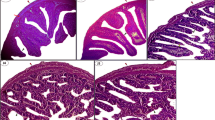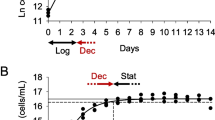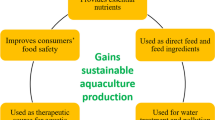Abstract
The effects of using thraustochytrid Schizochytrium sp. as source of lipid and fatty acids in a formulated diet on growth, survival, body composition, and salinity tolerance of juvenile donkey’s ear abalone, Haliotis asinina, were investigated. Treatments consisted of diets either containing a 1:1 ratio of cod liver oil (CLO) and soybean oil (SBO) (Diet 1) or thraustochytrid (Diet 2) as source of lipid and fatty acids at 2 % level. Natural diet Gracilariopsis heteroclada (Diet 3) served as the control. No significant difference in growth was observed in abalone fed Diet 3 (SGR: 5.3 % BW day−1; DISL: 265 μm day−1) and Diet 2 (SGR: 5.2 % BW day−1; DISL: 255 μm day−1). Survival ranged from 78 to 85 % for all treatments and was not significantly different from each other. A 96-h salinity stress test showed highest survival of 84 % in abalone fed Diet 2 compared with those fed diets 1 and 3 (42 %). The high growth rate of abalone fed Diet 2 and high tolerance to low salinity could be attributed to its high DHA content (8.9 %), which resulted to its high DHA/EPA ratio of 10.5 %. These fatty acids play a significant role in abalone nutrition. The fatty acid profile of abalone meat is a reflective of the fatty acid profile of the oil sources in the diet. The present study suggests that the use of Schizochytrium oil in lieu of CLO and SBO can support good growth of abalone which is comparable with abalone fed the natural seaweeds diet.

Similar content being viewed by others
References
Arafiles KHV, Alcantara JCO, Cordero PRF, Galura FS, Leaño EM, Dedeles GR (2011) Cultural optimization of Thraustochytrids for biomass and fatty acid production. Mycosphere 2:521–531
Association of Official Analytical Chemists (AOAC) (1975) In: Horwitz W, Chichilo P, Reynolds H (eds) Official methods of analysis, 12th edn. Washington DC, p 1094
Atalah E, Hernandez Cruz CM, Izquierdo MS, Rosenlund G, Caballero MJ, Valencia A, Robaina L (2007) Two microalgae Crypthecodinium cohnii and Phaeodactylum tricornutum as alternative source of essential fatty acids in starter feeds for seabream (Sparus aurata). Aquaculture 270:178–185
Barclay WB, Zeller S (1996) Nutritional enhancement of ω-3 and ω-6 fatty acids in rotifers and Artemia nauplii by feeding spray-dried Schizochytrium sp. J World Aquacult Soc 27:314–322
Batbatan CG, Hepowit NL, Oclarit JM (2011) Development historicity and saccharide heterotrophy of Schizochytrium sp. OT1: implication of docosahexaenoic acid production for biotechnological application. Asia Life Sci 20:289–305
Bautista-Teruel MN, Koshio SS, Ishikawa M (2011) Diet development and evaluation for juvenile abalone, Haliotis asinina Linne: lipid and essential fatty acid levels. Aquaculture 312:172–179
Boarder SJ, Maguire GB (1998) Evaluation of vitamin and mineral requirements for greenlip abalone Haliotis laevigata. In: Hone PW (ed) Proceedings of the 5th Abalone Aquaculture Workshop, A progress report, Fisheries Research and Development Corporation, Hobart Tasmania, Australia, 3–6 July 1998
Boarder SJ, Shpigel M (2001) Comparative performances of juvenile Haliotis roei fed on enriched Ulva rigida and various artificial diets. J Shellfish Res 20:653–657
Briggs MRP (1992) A stress test for determining vigour of post-larval Penaeus monodon Fabricius. Aquacult Fish Manage 23:633–637
Brix O (1983) Blood respiratory properties in marine gastropods. In: Brix O (ed) Environmental biochemistry and physiology. The Mollusca, vol 2. Academic Press, London, pp 51–76
Burja AM, Radianingtyas H, Windust A, Barrow CJ (2006) Isolation and characterization of polyunsaturated fatty acid producing Thraustochytrium species: screening of strains and optimization of ω-3 production. Appl Microbiol Biotechnol 72:1161–1169
Carter CG, Brandsden MP, Lewis TE, Nichols PD (2003) Potential of thraustochytrids to partially replace fish oil in Atlantic salmon feeds. Mar Biotechnol 5:480–492
Dhert P, Duray M, Lavens P, Sorgeloos P (1990a) Optimized feeding strategies in the larvae culture of Asian seabass Lates calcarifer. In: Hirano R, Hanyu I (eds) The Second Asian Fisheries Forum, Asian Fisheries Society, Tokyo, Japan, 17–22 Apr 1989, pp 319–323
Dhert P, Lavens P, Duray M, Sorgeloos P (1990b) Improved larval survival at metamorphosis of Asian seabass (Lates calcarifer) using ω-3-HUFA-enriched live food. Aquaculture 90:63–74
Dunstan GA, Baillie HJ, Barett SM, Volkman JK (1996) Effect of diet on the lipid composition of wild and cultured abalone. Aquaculture 140:115–127
Durazo-Beltran E, D’abramo LR, Toro-Vazquez JF, Vazquez-Pelaez C, Viana MT (2003) Effect of triacylglycerols in formulated diets on growth and fatty acid composition in tissue of green abalone, Haliotis fulgens. Aquaculture 224:257–270
Durazo-Beltran E, Viana MT, D’abramo LR, Toro-Vazquez JF (2004) Effects of starvation and dietary lipid on the lipid and fatty acid composition of muscle tissue of juvenile green abalone (Haliotis fulgens). Aquaculture 238:329–341
Estudillo-Del Castillo C, Gapasin RSJ, Leaño EM (2009) Enrichment potential of HUFA- rich thraustochytrid Schizochytrium mangrovei for the rotifer Brachionus plicatilis. Aquaculture 193:57–61
Fan KW, Chen F, Jones EBG, Vrijimoed LLP (2001) Eicosapentaenoic and docosahexaenoic acids production by and okara-utilizing potential of thraustochytrids. J Ind Microbiol Biotech 27:199–202
Feed Development Section (1994) Feeds and feeding of Milkfish, Nile Tilapia, Asian Sea Bass, and Tiger Shrimp. SEAFDEC Aquaculture Department, Tigbauan, Iloilo, Philippines, p 97
Folch J, Lee M, Stanley GHS (1957) A simple method for the isolation and purification of total lipids in animal tissues. J Biol Chem 226:497–506
Furuita H, Konishi K, Takeuchi T (1999) Effect of different levels of eicosapentaenoic acid and docosahexaenoic acid in Artemia nauplii on growth, survival and salinity tolerance of larvae of the Japanese Flounder, Paralichthys olivaceus. Aquaculture 170:59–69
Gallager SM, Mann R, Sasaki GC (1986) Lipid as an index of growth and viability in three species of bivalve larvae. Aquaculture 56:81–103
Ganuza E, Benitez-Santana T, Atalah E, Vega-Orellana O, Ganga R, Izquierdo MS (2008) Crypthecodinium cohnii and Schizochytrium sp. as potential substitutes to fisheries-derived oils from seabream (Sparus aurata) microdiets. Aquaculture 277:109–116
Gordon N, Neori A, Shpigel M, Lee J, Harpaz S (2006) Effect of diatom diets on growth and survival of the abalone Haliotis discus hannai postlarvae. Aquaculture 252:225–233
Hosseini SV, Kenari AA (2010) Effects of alternative dietary lipid sources on growth performance and fatty acid composition of beluga sturgeon Huso huso juveniles. J World Aquacult Soc 41:471–789
Kanazawa A (1997) Effects of docosahexaenoic acid and phospholipids on stress tolerance of fish. Aquaculture 155:129–134
Kayama M, Araki S, Sato S (1989) Lipids of marine plants. In: Ackman RG (ed) Marine biogenics lipids, fats and oils, vol II. CRC Press, Boca Raton, pp 49–143
Langdon C, Onal E (1999) Replacement of living microalgae with spray-dried diets for the marine mussel Mytilus galloprovincialis. Aquaculture 180:283–294
Leaño EM (2001) Straminipilous organisms from fallen mangrove leaves from Panay Island, Philippines. Fungal Divers 6:75–81
Leaño EM, Liao IC (2007) Thraustochytrids: Ecological role and potential commercial use. In: Reichardt W (ed) Challenges of applied environmental microbiology in marine science, Proceedings of Deutscher Akademischer Austausch Dienst (DAAD) Conference, Marine Science Institute, University of the Philippines, Diliman, Quezon City, 18 Jan 2007, pp 39–42
Leaño EM, Gapasin RSJ, Polohan B, Vrijmoed L (2003) Growth and fatty acid production of thraustochytrids from Panay mangroves, Philippines. Fungal Divers 12:111–122
Lee SM (2004) Utilization of dietary protein, lipid and carbohydrate by abalone (Haliotis discus hannai): a review. J Shellfish Res 23:1027–1030
Mai K, Mercer JP, Donlon J (1995) Comparative studies on the nutrition of two species of abalone, Haliotis tuberculata L. and Haliotis discus hannai Ino III. Response of abalone to various levels of dietary lipid. Aquaculture 134:65–80
Mai K, Mercer JP, Donlon J (1996) Comparative studies on the nutrition of two species of abalone, Haliotis tuberculata L. and Haliotis discus hannai Ino. V. The role of polyunsaturated fatty acids of macroalgae in abalone nutrition. Aquaculture 139:77–89
Metcalfe LD, Schmitz AA, Pelka JR (1966) The rapid preparation of fatty acid esters for gas chromatographic analysis. Anal Chem 38:514–515
Mulvaney WJ, Jahangard S, Ingram BA, Turchini GM, Winberg PC (2015) Recovery of omega-3 profiles of cultivated abalone by dietary macroalgae supplementation. J Appl Phycol 27(5):2163–2171
Nakahara T, Yokochi T, Higashihara T, Tanaka S, Yaguchi T, Honda D (1996) Production of Docosahexaenoic acid and Docosapentaenoic acids by Schizochytrium sp. isolated from Yap Islands. J Am Oil Chem Soc 73:1421–1426
Oclarit JM, Hepowit NL (2007) Thraustochytrids from mangroves: A rich new source of essential fatty acids for human nutrition. In: Reichardt W (ed) Challenges of applied environmental microbiology in Marine Science, Proceedings of Deutscher Akademischer Austausch Dienst (DAAD) Conference, Marine Science Institute, University of the Philippines, Diliman, Quezon City, 18 Jan 2007, pp 35–38
Pereira SL, Leonard AE, Huang YS, Chuang LT, Muker JIP (2004) Identification of two novel microalgae enzymes involved in the conversion of the ω-3-fatty acid, eicosapentaenoic acid, into docosahexaenoic acid. Biochem J 384:357–366
Samocha TM, Guajardo H, Lawrence AL, Castille FL, Speed M, Mckee DA, Page KI (1998) A simple stress for Penaeus vannamei. Aquaculture 165:233–242
Sargent JR, McEvoy LA, Bell JG (1997) Requirements, presentation and sources of polyunsaturated fatty acids in marine fish larval feeds. Aquaculture 155:117–127
Uki N, Kemuyama A, Watanabe T (1985) Development of semi-purified diets for abalone. Bull Jpn Soc Fish 52:1005–1012 (in Japanese, with English abstract)
Uki N, Suguira M, Watanabe T (1986) Requirement of essential fatty acids in the abalone Haliotis discus hannai. Bull Japan Soc Sci Fish 52:1013–1023 (in Japanese, with English abstract)
Xu W, Mai K, Zhang W, Liufu Z, Tan B, Ma H, Quinghiu L (2004) Influence of dietary lipid sources and fatty acid composition of juvenile abalone, Haliotis discuss hannai Ino. J Shellfish Res 23:1041–1044
Yaguchi T, Tanaka S, Yokochi T, Nakahara T, Higashihara T (1997) Production of high yields of Docosahexaenoic acid by Schizochytrium sp. Strain SR21. J Am Oil Chem Soc 74:1431–1434
Yokochi T, Honda D, Higashihara T, Nakahara T (1998) Optimization of Docosahexaenoic acid production by Schizochytrium limacinum SR21. Appl Microbiol Biotecnol 49:72–76
Yokohama R, Honda D (2007) Taxonomic rearrangement of the genus Schizochytrium sensu lato based on morphology, chemotaxonomic characteristics, and 18S rRNA gene phylogeny (Thraustochytriaceae, Labyrinthulomycetes): emendation for Schizochytrium and erection of Aurantiochytrium gen. nov. Mycoscience 48:199–211
Acknowledgments
The authors are indebted to SEAFDEC/AQD for the research grant, to Dioscoro T. de la Peña, Jr. and Dr. Pamela-Di R. de la Peña for the useful insights and to the reviewer for the valuable comments in improving this manuscript.
Author information
Authors and Affiliations
Corresponding author
Rights and permissions
About this article
Cite this article
de la Peña, M.R., Teruel, M.B., Oclarit, J.M. et al. Use of thraustochytrid Schizochytrium sp. as source of lipid and fatty acid in a formulated diet for abalone Haliotis asinina (Linnaeus) juveniles. Aquacult Int 24, 1103–1118 (2016). https://doi.org/10.1007/s10499-016-9974-3
Received:
Accepted:
Published:
Issue Date:
DOI: https://doi.org/10.1007/s10499-016-9974-3




